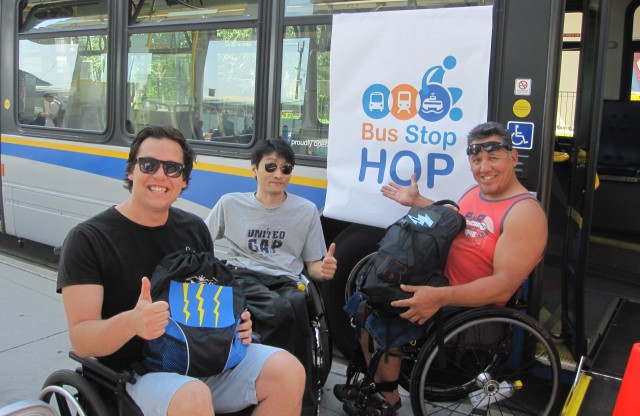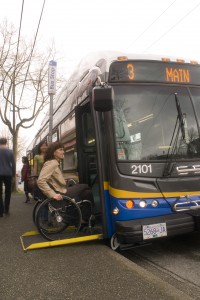Spinal Cord Injury BC’s Bus Stop Hop showcases accessible transit
Spinal Cord Injury BC’s Bus Stop Hop showcases accessible transit

Using transit with your wheelchair or mobility aid for the first time can be a daunting task if you don’t know what to expect. That’s the reason why Spinal Cord Injury BC (SCI-BC) organizes the annual Bus Stop Hop.
They aim to showcase just how accessible Metro Vancouver’s transit system is and provide wheelchair and mobility aid users an opportunity to become familiar and comfortable with the system. It is the only wheelchair accessible urban scavenger hunt in Vancouver.
In the 14th year of this Amazing Race-inspired event, developed in partnership with TransLink, teams of four raced across the city using public transportation to complete challenges and collect points by answering trivia questions and participating in activities. Each team consisted of two ambulatory participants and two who use mobility aids.
Matt Human and Sarah Chung, Community Relations Coordinators with Access Transit, both attended this year’s event on Saturday, July 26. Matt competed on a team called the Lightning Boys with Soung-Han Kim and Richard Peter from SCI-BC, while Sarah was a facilitator for one of the challenges at the Bridgeport Bus Loop. TransLink’s Norm Fraser and CMBC’s Liina Marshall also participated and finished a close second in a spirited sprint to the finish.
In sum, ten different teams participated in Bus Stop Hop. The event took them on board the bus, SkyTrain, and SeaBus to Olympic Village, Science World, Lonsdale Quay, YVR-Airport and Richmond-Brighouse.
“Our team may not have finished first, but we had a lot of fun racing across Metro Vancouver completing the challenges,” Matt says. “The hardest part of the day was keeping cool, but our air-conditioned cars on Canada Line really helped!
“It was a great experience and a fantastic way to showcase the accessibility of TransLink’s network of services. Helping passengers who use mobility aids to become familiar with public transportation is really important so that everyone can get where they need to go and be confident doing so.”
“TransLink is constantly adjusting service to meet the needs of the region, so it was good to showcase all of the accessibility features as they evolve as well.”
Since adopting the Access Transit Strategy in 2007, TransLink has implemented a number of initiatives to make the transit system more accessible for more people.

TransLink’s fleet of buses, community shuttle minibuses, SkyTrain, SeaBus and West Coast Express vehicles are all fully accessible. Low-floor vehicles have ramps and high-floor vehicles have lifts, and all SkyTrain stations have elevators.
The entire bus fleet in 2008 was outfitted with annunciators and LED displays that automatically announce and display the next stop for passengers. On the web, TransLink’s website conforms to the Web Accessibility Initiative’s Priority Level AA.
Currently, TransLink is piloting wayfinding signage that provides information in both visual and tactile media. There is also a program in place to share the cost of improvements to bus stops with municipalities to improve accessibility around the region.
Through the Access Transit Department, TransLink offers a variety of programs to ensure people with disabilities, seniors and new immigrants are comfortable and confident when using public transit.
These include presentations, group tours and one-on-one orientations on the accessibility features of the transit system. Coast Mountain Bus Company also offers training sessions at the Vancouver Transit Centre on how to board and exit a bus using a mobility aid.
“Thanks to SCI-BC and all of the other sponsors for their support of this great event and we look forward to participating again next year.”
More information about Accessible Transit can be found by clicking here.
Author: Allen Tung






Its a good website. Thanks for giving full information about Transit Wheelchairs. You can also check at wheelchaircentral.in